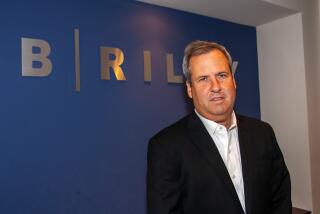The Saga of Keating and Lincoln Savings
- Share via
1984
Feb. 22: Keating uses his American Continental Corp. real estate development company to acquire the 58-year-old Lincoln Savings & Loan for $51 million.
1986
March 12: Examiners at the Federal Home Loan Bank in San Francisco begin routine audit of Lincoln.
Nov. 3: American Continental wins state approval to sell $200 million in corporate bonds. Sales begin in early December out of Lincoln’s Southern California branches.
1987
April 2: Four U.S. senators, including Alan Cranston (D-Calif.), who received big contributions from Keating, meet in private with a top federal regulator on Keating’s behalf.
May 1: Federal agents in San Francisco recommend to superiors in Washington that Lincoln be seized or be subjected to stiff regulatory orders.
1988
May 20: Regulators and Lincoln sign memorandum of understanding aimed at wiping slate clean.
May 26: American Continental wins approval to sell $300 million more in bonds.
1989
April 13: American Continental and 11 Lincoln subsidiaries file for bankruptcy protection, rendering $250 million in bonds worthless.
April 14: Regulators seize Lincoln. It becomes nation’s biggest thrift failure, costing taxpayers an estimated $2.6 billion.
Sept. 15: Resolution Trust Corp., the federal agency managing Lincoln, files fraud and racketeering charges against Keating and others. The action is later amended to seek $2.6 billion in damages.
1990
Aug. 23: A federal judge, accusing Keating of “looting” Lincoln, rejects Keating’s claims that regulators unlawfully seized the S&L.;
Sept. 18: A 42-count indictment by a California grand jury charges Keating and three others with violating state securities laws by defrauding bondholders. Keating spends 33 days in jail, unable to post bail until it is reduced from $5 million to $300,000.
1991
Aug. 2: Trial on state fraud charges begins.
Dec. 4: After 52 people testify for the prosecution, defense rests without calling any witnesses; Keating is convicted on 17 of the 18 charges.
Dec. 12: Keating and four associates are indicted in Los Angeles on 77 federal criminal counts of racketeering, fraud and conspiracy. In a separate action, the Securities and Exchange Commission files a civil suit against Keating and nine others, alleging securities fraud and insider trading.
1992
Jan. 15: In a complaint similar to the one filed in Los Angeles, Keating and associates are indicted by a federal grand jury in Phoenix on five criminal counts.
March 17: Testimony begins in Tucson in the suit brought by 23,000 small investors.
April 10: Judge in state fraud trial sentences Keating to 10 years in prison and fines him $250,000.
July 10: In the largest civil judgment against an individual in U.S. history, the jury in Tucson orders Keating to pay $2.1 billion in damages and assesses his three associates damages that could total $2.3 billion.
Oct. 21: U.S. district judge reduces the total jury award against Keating and his associates from $4.4 billion to $1.5 billion.
Nov. 3: Keating’s federal trial begins in U.S. District Court in Los Angeles.
Dec. 8: Keating testifies in his own defense for the first time in three years.
1993
Jan. 6: After five days of deliberation, jurors convict Keating on 73 counts of racketeering, conspiracy and fraud; his son, Charles H. Keating III, is convicted on 64 counts.
Source: Times’ reports; researched by DALLAS M. JACKSON / Los Angeles Times
More to Read
Inside the business of entertainment
The Wide Shot brings you news, analysis and insights on everything from streaming wars to production — and what it all means for the future.
You may occasionally receive promotional content from the Los Angeles Times.










